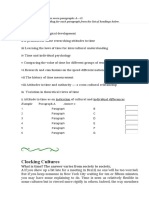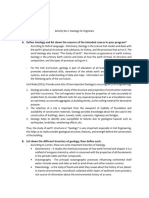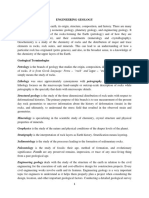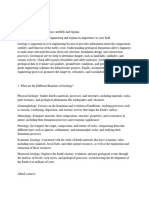0 ratings0% found this document useful (0 votes)
5 viewsSabo Geology
Sabo Geology
Uploaded by
Ellah saboCopyright:
© All Rights Reserved
Available Formats
Download as DOCX, PDF, TXT or read online from Scribd
Sabo Geology
Sabo Geology
Uploaded by
Ellah sabo0 ratings0% found this document useful (0 votes)
5 views2 pagesCopyright
© © All Rights Reserved
Available Formats
DOCX, PDF, TXT or read online from Scribd
Share this document
Did you find this document useful?
Is this content inappropriate?
Copyright:
© All Rights Reserved
Available Formats
Download as DOCX, PDF, TXT or read online from Scribd
Download as docx, pdf, or txt
0 ratings0% found this document useful (0 votes)
5 views2 pagesSabo Geology
Sabo Geology
Uploaded by
Ellah saboCopyright:
© All Rights Reserved
Available Formats
Download as DOCX, PDF, TXT or read online from Scribd
Download as docx, pdf, or txt
You are on page 1of 2
Sabo, Ellah Cielo P.
April 1, 2024
ENGG-0203 – Geology for Civil Engineers Score:
1. What is the importance of learning Geology in the CE profession?
The importance of learning Geology is to the core component of engineering
analysis and computations. Will enable to understand and appreciate civil
engineering by profession.
2. Differentiate the theory of continental drift and plate tectonics.
Continental drift was developed in the early part of the 20 th century, mostly
Alfred Wegener. All of earth’s continents were once part of an enormous, single
landmass called Pangaea, existed about 240 million years ago and began
breaking up about 200 million years ago. Pannotia and Rodinia are the other
supercontinents of continental drift. While plate tectonics is a scientific theory of
the large-scale motion of 7 large plates and movements of larger number of
smaller plates. It began between 3.3 to 3.5 billion years ago. The two types of
tectonic plates are the oceanic plates and continental plates. The 7 major
tectonics plates are the following; South American Plate, Indo-Australian Plate,
Antarctic Plate, African Plate, Eurasian Plate, North American Plate, and Pacific
Plate.
3. How do you think land formations are created?
Landforms are created by both endogenic and exogenic force. Endogenic forces
are sudden forces such as earthquakes, volcanoes, and landslides. Exogenic
forces include water, wind, sea waves, and glaciers, which generated erosive
and depositional landforms.
4. Why is weathering an important factor to consider in the CE profession?
Weathering is important to engineers because it can help them to understand
how buildings and other structures will be affected by the environment.
5. Where is water stored?
The water is stored in aquifers.
6. What is the importance of learning basic concepts of earthquake in CE
profession?
Understanding the basic concepts of earthquakes is important for civil engineers
because it allows them to design and build safe, solid buildings.
Sabo, Ellah Cielo P. April 1, 2024
ENGG-0203 – Geology for Civil Engineers Score:
7. In your own opinion, how are minerals formed?
Minerals are formed in one of two ways: by cooling magma under the crust or by
separating elements dissolved in water.
8. Why is it important for CE students to understand the qualities of
minerals?
Civil engineers must understand the basic physical, chemical, mechanical, and
electrical properties of the materials utilized in the building industry. Civil
engineers must understand the basic characteristics of materials used in building
to determine their quality, shrinkage, and swelling properties. This ensures the
structure's endurance.
9. What are the most common minerals found in CE construction materials?
Crystalline silica is a common mineral found in materials for construction such as
sand, stone, concrete, brick, and mortar.
10. Discuss fossil fuels.
Fossil fuels are derived from decaying plants and animals. These fuels are
present in the Earth's crust and include carbon and hydrogen, which may be
burnt to generate energy. Fossil fuels include coal, oil, and natural gas.
You might also like
- Clocking CulturesDocument5 pagesClocking CulturesLeyla50% (2)
- Geology in Civil EngineeringDocument108 pagesGeology in Civil EngineeringKnowell Jan PartozaNo ratings yet
- Ceglgy20 1Document4 pagesCeglgy20 1genrevjuan13No ratings yet
- Geological Consideration in Engineering by S Tabon EXCERPT DRAFT PDFDocument10 pagesGeological Consideration in Engineering by S Tabon EXCERPT DRAFT PDFMoira Elizabeth SyNo ratings yet
- Geology and Civil Engineering RelationshipDocument3 pagesGeology and Civil Engineering RelationshipCHRISTIAN NATHANIEL PALMA100% (1)
- UntitledDocument7 pagesUntitledEDWINNo ratings yet
- Engineering Geology Lecture 1 &2Document62 pagesEngineering Geology Lecture 1 &2Boos yousufNo ratings yet
- Engineering Geology 1st UnitDocument9 pagesEngineering Geology 1st UnitSaikrupaVempatiNo ratings yet
- Unit-i. Introduction to Geology& Engineering Geology (1)Document77 pagesUnit-i. Introduction to Geology& Engineering Geology (1)MITIMA JabbyNo ratings yet
- CEG225 - Relevance of Geology To Engineering and Earth StructureDocument5 pagesCEG225 - Relevance of Geology To Engineering and Earth StructurePrincewillNo ratings yet
- Unit 1 Physical GeologyDocument54 pagesUnit 1 Physical GeologyMildred CardenasNo ratings yet
- Engineering Geology Unit 1Document7 pagesEngineering Geology Unit 1Hemanth KumarNo ratings yet
- Book Geology in Engineering by S Tabon Draft Excerpt 2022 PDFDocument16 pagesBook Geology in Engineering by S Tabon Draft Excerpt 2022 PDFMoira Elizabeth SyNo ratings yet
- Ology in Civil EngineeringDocument95 pagesOlogy in Civil EngineeringPraz Aarash100% (1)
- Why Is The Origin of The Earth and The Internal Structure of The Earth Important To Civil EngineeringDocument3 pagesWhy Is The Origin of The Earth and The Internal Structure of The Earth Important To Civil EngineeringHarrington HaynesNo ratings yet
- 1 Ch1 and 2 Introduction and Relationship Between Eng Geology and Structures 2022 2023Document19 pages1 Ch1 and 2 Introduction and Relationship Between Eng Geology and Structures 2022 2023Yousif MawloodNo ratings yet
- The Science of Geology What Is Geology?Document24 pagesThe Science of Geology What Is Geology?Zekariyas AbushaNo ratings yet
- Geology Midterm NotesDocument7 pagesGeology Midterm NotesMharibelle AmbaNo ratings yet
- Book Geology in Engineering by S Tabon Excerpt 2022 Edited Drafted 3 23 Pointer 1 Q2 Chapter 3 ExcerptDocument19 pagesBook Geology in Engineering by S Tabon Excerpt 2022 Edited Drafted 3 23 Pointer 1 Q2 Chapter 3 ExcerptMoira Elizabeth SyNo ratings yet
- Soil Mechanics I.handoutDocument114 pagesSoil Mechanics I.handoutZeleke Taimu100% (1)
- 1 Intro GeologyDocument46 pages1 Intro GeologyNatsu IgneelNo ratings yet
- Module 5-7 - CeoDocument14 pagesModule 5-7 - CeoAndrei Yuri DiñoNo ratings yet
- Relevance of Engineering Geology To Civil EngineeringDocument9 pagesRelevance of Engineering Geology To Civil EngineeringIfiokobong AkpanNo ratings yet
- 1.introduction To Engg. Geology & SeismologyDocument32 pages1.introduction To Engg. Geology & SeismologyZindai WazirNo ratings yet
- ES CE - Civil Engineering Orientation Lecture Notes - 4Document10 pagesES CE - Civil Engineering Orientation Lecture Notes - 4Mae TadaNo ratings yet
- Engineering Geology Unit 1Document116 pagesEngineering Geology Unit 1shivakumar penugondaNo ratings yet
- A1 GeologyDocument2 pagesA1 GeologyRheyland FernandezNo ratings yet
- Kathmandu University: Department of Civil & Geomatics EngineeringDocument29 pagesKathmandu University: Department of Civil & Geomatics EngineeringNitish ShahNo ratings yet
- Geology 229 Engineering Geology: The Syllabus and Introduction (West, Chs. 1, 20)Document25 pagesGeology 229 Engineering Geology: The Syllabus and Introduction (West, Chs. 1, 20)Shaikh NafisaNo ratings yet
- Chapter One General Introduction and Definition of SoilDocument4 pagesChapter One General Introduction and Definition of SoilHiwot DemisseNo ratings yet
- Module 1.1-1.3 (Introduction of Geology, Structure of The Earth, and Continental Drift Theory and Plate Tectonics)Document47 pagesModule 1.1-1.3 (Introduction of Geology, Structure of The Earth, and Continental Drift Theory and Plate Tectonics)Anonymous 09No ratings yet
- Chapter 1 GeologyDocument48 pagesChapter 1 GeologylovryantadenaamilingacadsNo ratings yet
- Geology Ass FinalDocument4 pagesGeology Ass FinalAngela ElumbaNo ratings yet
- MODULE-1-2-3-4 - GeologyDocument24 pagesMODULE-1-2-3-4 - GeologyLIM KESSAH MARIENo ratings yet
- Geology PrelimDocument42 pagesGeology PrelimswingjnielsynNo ratings yet
- Geotech2 - LS1 - Origin of SoilsDocument10 pagesGeotech2 - LS1 - Origin of SoilsRudiny FarabyNo ratings yet
- Reviewer Quiz 1Document11 pagesReviewer Quiz 1choialexander29No ratings yet
- BCE221Document6 pagesBCE221Roxan ReyesNo ratings yet
- MinE-170, Lecture 1Document87 pagesMinE-170, Lecture 1Hadh HaraamNo ratings yet
- Elebare SummaryDocument6 pagesElebare SummaryBayot Aliana Vine A.No ratings yet
- Tlo 1 General GeologyDocument17 pagesTlo 1 General GeologyUploader101No ratings yet
- Notes 1Document59 pagesNotes 1Burkan YayçıNo ratings yet
- Eg PPT - 1Document43 pagesEg PPT - 1Rohit PatilNo ratings yet
- Yoni Assignment 1Document46 pagesYoni Assignment 1Yoni RebumaNo ratings yet
- Chapter 1Document30 pagesChapter 1solomon.mulukenNo ratings yet
- Geotechnics - C1Document43 pagesGeotechnics - C1Dorin TeodorescuNo ratings yet
- CE-312 Engineering Geology and Seismology (Theory) Credit Hours 3Document20 pagesCE-312 Engineering Geology and Seismology (Theory) Credit Hours 3Hammad AhmadNo ratings yet
- A History and GSDDocument53 pagesA History and GSDshanab9722No ratings yet
- Geology and Geoengineering PDFDocument141 pagesGeology and Geoengineering PDFMuawiyahNo ratings yet
- Ce8392 2marksDocument10 pagesCe8392 2marksVishnuNo ratings yet
- Cve 341 2023.2024 Class MaterialDocument33 pagesCve 341 2023.2024 Class MaterialblakeherlinNo ratings yet
- Unit IDocument34 pagesUnit IChristian Widiasmoro PutroNo ratings yet
- Engineering Geology Unit-1Document31 pagesEngineering Geology Unit-1bikkmakkbillNo ratings yet
- Geology For Civil Engineers - E21 & E23: I. Branches of GeologyDocument5 pagesGeology For Civil Engineers - E21 & E23: I. Branches of GeologyJanu GolezNo ratings yet
- Cuachon Cegeol220 Activityno02Document6 pagesCuachon Cegeol220 Activityno02Emriel John L. CuachonNo ratings yet
- Introduction To GeologyDocument4 pagesIntroduction To GeologyJersey Mae PerlasNo ratings yet
- Unit 1.3 WeatheringDocument6 pagesUnit 1.3 WeatheringJoshua John JulioNo ratings yet
- Chapter One SoilDocument42 pagesChapter One SoildasseasafaNo ratings yet
- Concrete in The Marine Environment PDFDocument216 pagesConcrete in The Marine Environment PDFgokulcivilionsNo ratings yet
- Engineering Geology 1Document203 pagesEngineering Geology 1B Divya jyothiNo ratings yet
- DLP ChemDocument2 pagesDLP ChemMichelle NicolasNo ratings yet
- Topic: The Family As A Basic Autonomous Social InstitutionDocument2 pagesTopic: The Family As A Basic Autonomous Social InstitutionVener Angelo MargalloNo ratings yet
- Criminology Curriculum Effective AY 2023 2024 3RDYEAR 1STSEWMDocument2 pagesCriminology Curriculum Effective AY 2023 2024 3RDYEAR 1STSEWMmarkgabrielpatagan39No ratings yet
- VerifyCopy (1) - 240304 - 180954Document2 pagesVerifyCopy (1) - 240304 - 180954clementmensah417No ratings yet
- Engineering Mechanics Gear CouplingDocument4 pagesEngineering Mechanics Gear Couplingfrank barringtonNo ratings yet
- Pola Pendidikan Dan Pola Dakwah Islamic Centre Mu'Adz Bin Jabal (Icm) Di Kota KendariDocument23 pagesPola Pendidikan Dan Pola Dakwah Islamic Centre Mu'Adz Bin Jabal (Icm) Di Kota KendariGala JatiNo ratings yet
- Treatment Rapid Sand Filtration Feb14 v2Document14 pagesTreatment Rapid Sand Filtration Feb14 v2Ali HadiNo ratings yet
- 17th and 18th Century LiteratureDocument69 pages17th and 18th Century LiteratureJopie ArandaNo ratings yet
- Maria Pappas - ResumeDocument1 pageMaria Pappas - Resumeapi-540091781No ratings yet
- Employee Work-Life Balance As An HR ImperativeDocument19 pagesEmployee Work-Life Balance As An HR ImperativeMandar GotmareNo ratings yet
- Soal UAS EFC 2 UMB 2022 - Juli 6Document3 pagesSoal UAS EFC 2 UMB 2022 - Juli 6Kris HadinataNo ratings yet
- Sensory Circuit Info and Ideas For School and HomeDocument11 pagesSensory Circuit Info and Ideas For School and HomeJulie SharpNo ratings yet
- Chapter - 2 Study Area and MethodologyDocument42 pagesChapter - 2 Study Area and Methodologyhram_phdNo ratings yet
- 1 PBDocument12 pages1 PBdewi arumNo ratings yet
- Sets - Word ProblemsDocument2 pagesSets - Word ProblemsCamille LopezNo ratings yet
- Saint Louis University: School of Nursing Family Nursing Assessment ToolDocument3 pagesSaint Louis University: School of Nursing Family Nursing Assessment ToolAmira Fatmah QuilapioNo ratings yet
- HELIOS Road Marking Brochure 2021 ENG WEBDocument11 pagesHELIOS Road Marking Brochure 2021 ENG WEBUmesh MishraNo ratings yet
- Purple Hibiscus - Adarsh Ma'amDocument7 pagesPurple Hibiscus - Adarsh Ma'amsehar jaggiNo ratings yet
- Pekerjaan General Overhaul Engine Cummins Kta 19-G3 Untuk Alat B/M Rubber Tyre Gantry (RTG) #01 Di Terminal Petikemas KariangauDocument1 pagePekerjaan General Overhaul Engine Cummins Kta 19-G3 Untuk Alat B/M Rubber Tyre Gantry (RTG) #01 Di Terminal Petikemas Kariangauphilip connieNo ratings yet
- Lion Brand Homespun: Hooded Knit SweaterDocument5 pagesLion Brand Homespun: Hooded Knit Sweaterbetty_lozanoNo ratings yet
- Vol 16 No 2 Fein Review of Freinacht The Listening SocietyDocument13 pagesVol 16 No 2 Fein Review of Freinacht The Listening SocietypatricivscornelivsNo ratings yet
- Survey Questionnaires 0.1Document4 pagesSurvey Questionnaires 0.1Carl Anthony MendozaNo ratings yet
- Crossroads February 2013Document4 pagesCrossroads February 2013Xaverian Missionaries USANo ratings yet
- Judge Dadole v. Commission On AuditDocument2 pagesJudge Dadole v. Commission On AuditNoreenesse SantosNo ratings yet
- Software Requirements Specification FORDocument7 pagesSoftware Requirements Specification FORAMAN DIXITNo ratings yet
- Demo Math 4 Place Value and Value of Numbers First QuarterDocument3 pagesDemo Math 4 Place Value and Value of Numbers First QuarterMJNo ratings yet
- Disabled Justice - Access To Justice and The UN Convention On The Rights of Persons With DisabilitiesDocument190 pagesDisabled Justice - Access To Justice and The UN Convention On The Rights of Persons With DisabilitiesSmita PandeyNo ratings yet
- 02-18-005 BIM Revit Modeling RFP FinalDocument12 pages02-18-005 BIM Revit Modeling RFP FinalSantosh NathanNo ratings yet
























































































